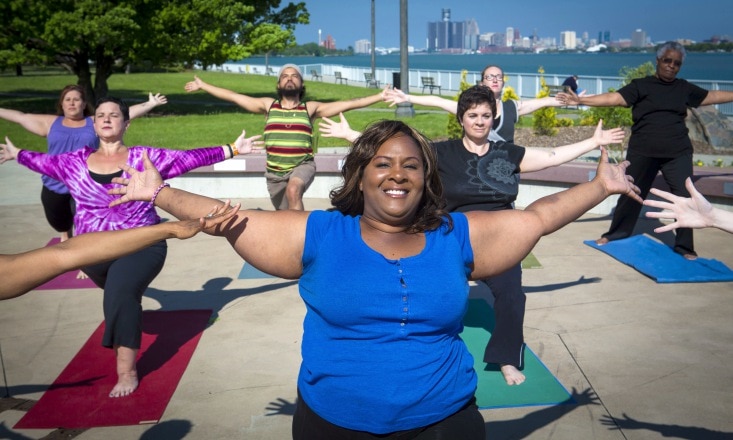Being a fat, black woman in a fatphobic, sexist, and racist society means that I must face difficult challenges on a daily basis. The one place you wouldn’t expect to confront these challenges is on the yoga mat. In yoga culture, we preach oneness and love, but sadly, our words often belie our actions.
I’ve been a full time yoga teacher and educator for over 20 years, and through my teachings, I’ve learned a lot about the human condition. What occurs in the real world is often reflected back to us on our yoga mats.
We live in a society that is steeped in judgement, prejudice, and bias. These are learned conditions that affect all of us. Our yoga mats and yoga culture are not immune to the prevalence of a growing sense of exclusion and ‘otherness’—despite how hypocritical these experiences may be to the fundamental teachings of this ancient practice.
The Reactions to Seeing Fat Yoga Students and Teachers
As a yoga student, I’ve watched people move their mats away from me, stop talking when I enter a space, and discredit my abilities based on my skin colour and size. As a teacher and studio owner, my training, abilities and authenticity are constantly questioned.
I’m never sure if the bias and prejudice I face on the mat are based on my skin colour or my body size, but I think it’s likely a combination of both.
The Assumption That You're Not a Good Teacher Because of Your Size
More often than not, students and teachers are surprised by my abilities, knowledge, and expertise. There is a sense of wonder that emanates from the room when it’s revealed that I’m a yoga teacher. There's a sense of confusion then emerges when students realize that I’m a great teacher.
After all, I don’t fit the stereotype of thin, flexible, and white. In our current yoga culture, the most prominent yoga celebrities are paragons of the idealized standards of beauty—young, white, hypermobile, and attractive, with one or two exceptions, of course.
As a curvy yoga teacher, there’s an assumption that I won’t be as good as my thinner counterparts. It's as if spirituality and competency can only come in a small, white package. Truth be told, I find yoga to be one of the most judgmental, "non-judgmental" practices in the world. Too many divisions have been created along the lines of body size, ability, race, gender, and social class.
Getting people to change their minds about what a yogi looks like is a gruelling task. But, expanding our views is necessary in creating safe and brave spaces where everyone can participate and feel welcomed.
Why I Keep Showing Up, And Why You Should, Too
Yoga is in all of us, and yoga is for all us. Showing up as a fat, black teacher invites other bigger bodies to show up too. There is a sense of safety and support that accompanies representation. We all want to feel like we belong. Breaking down the stereotypes surrounding what a yogi looks like starts with offering more images and classes that feature diverse bodies.
I serve my community by showing up and teaching from my heart, and I urge more teachers to do the same.
How to Overcome These Challenges? Stay Focused.
In order to overcome my challenges as an abundant bodied yoga teacher, I’ve had to learn that other people's opinions of me are none of my business. It’s important for me not to internalize anyone else's bias and judgment.
I’m here to break down the stereotype of what a yogi looks like, and I can’t do that if I let others define who I am as a teacher, or what a yoga teacher should look like. For every student that walks away from my teachings, there is another student walking towards me who sees a little or a lot of themselves reflected in the person I am. Perhaps a student who has been too intimidated to try yoga has come to my class because they know it is a safe space for personal growth.
What's Your Dharma or Purpose?
My main goal or dharma in my yoga practice is to create a bridge to a greater understanding of humanity and the spirituality that links us together. I also recognize that those who judge others based on their size, social class, gender or skin colour have a lot of self-reflection to do—and that is their dharma.
Other people’s thoughts or ideas of me have nothing to do with me or my purpose.
To my fellow abundant-bodied yoga teachers, I want to remind you that there are students waiting to come to your classes because you represent them, and this allows them to feel safe and included. Abundant yoga teachers help us to explore different perspectives on the mat, and this inclusion is necessary in inviting all bodies to experience the benefits of this practice.
All bodies are good bodies, and all bodies can teach yoga. Remember to be kind to your teachers and students, because after all, we are in this together.
Image credit: Erika Reid


